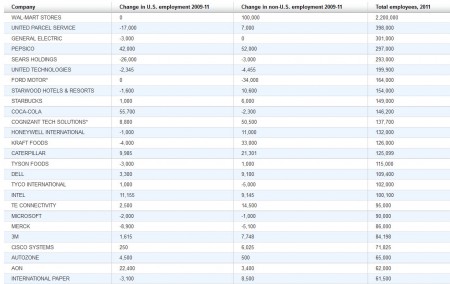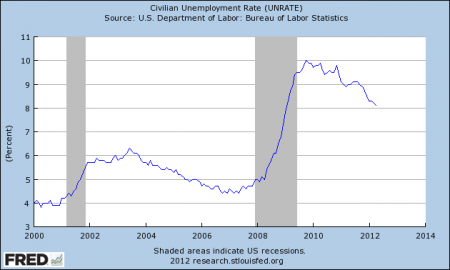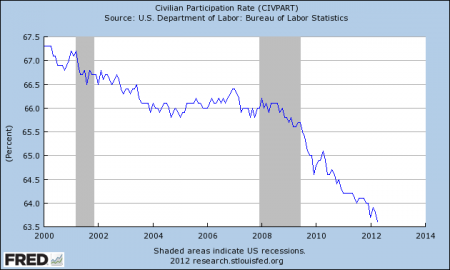Why still no robust employment recovery?
Gary Becker summarizes the reasons for the slow job recovery into three categories:
1. The aftermath of a big financial crisis, as explained by the research done by Reinhart and Rogoff;
2. Policy and regulation uncertainties hinder investment, although Corporate America are flooded with cash;
3. Relatively more generous unemployment benefits offer no immediate incentives for job seeking, keeping a non-negligible proportion of population out of labor force.
(graph courtesy of Calculated Risk)
The share of world’s manufacturing
According to Data Mine, the U.S. share of global manufacturing value has been on a fairly steady decline since 2000 as Chinese manufacturing has shot up, surpassing Germany in 1999 and Japan in 2007.
The decline of US manufacturing is relative. US manufacturing, on an absolute basis, is still growing. However, this is not the case for the manufacturing employment. More than one-third of American million manufacturing jobs disappeared between 1970 and 2010, while the Chinese now enjoy a total labor force five times that in the U.S.
Combining the two facts above, one can conclude that the growth of US manufacturing has relied on shedding domestic labor (incl. shifting manufacturing to China), and increasing productivity.
Jobless recovery – the role of multinationals
WSJ research reveals that the largest U.S.-based multinational companies added jobs much faster than other U.S. employers in the past two years, but nearly three-fourths of those jobs were overseas.
Between 2009 and 2011, these multinational firms boosted their employment at home by 3.1%, or 113,000 jobs, the same rate of increase as the nation’s other employers. But they also added more than 333,000 jobs in their far-flung—and faster-growing— foreign operations.
(click for details)
The unemployment puzzle
The official unemployment rate has been dropping:
Yet, employment to population ratio shows nothing has really improved:
So what to believe? Is US labor market thawing? Or are we still in a slump?
The official unemployment rate is calculated as the number of unemployed divided by labor force. Let’s use an example to illustrate. An economy has a total labor force of 100; if 10 is unemployed, then the unemployment rate is 10/100=10%.
To understand the issue, we need to appreciate how the labor force is calculated. If 3 out of 10 people who are previously unemployed drop out of labor force, because they are discouraged by not being able to find a job for quite some time, labor force now changes from 100 to 97. And the new unemployment rate is (10-3)/(100-3)=7/97=7.2%. This represents a 2.8% improvement, although the labor market condition has not improved at all.
Is this what’s happening now in the US? If so, it will show up in labor participation rate, which is defined as the ratio between total labor force and adult population. And let’s assume the adult population is 150. When there are discouraged workers giving up and exiting the labor market, labor participation rate drops from 100/150=67% to 97/150=65%.
Not surprisingly, that is what we see in the real data:
How the Detroit Three were transformed
How the US auto-industry regained its footing during the recent financial turmoil and became competitive again with foreign auto producers. A great illustration of how Joseph Schumpeter’s “creative destruction” can revitalize a failing industry.









